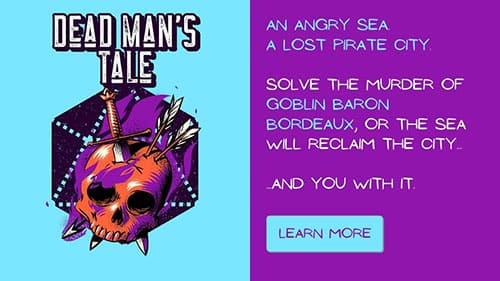Consider environmental elements, classic genre tropes and ancient mythology when building a desert campaign:
- What kind of desert is being used?
- How does the arid environment affect monster selection?
- Consider survival—the lost oasis hook
- Celestial encounters—pull inspiration from ancient mythology
- Run temples using a McGuffin—including traps, puzzles and temple monsters
- Try a Western campaign
Desert campaigns for RPGs like Dungeons and Dragons 5e and Pathfinder often include ancient temple runs, unique survival situations and cosmic wonders of an unobscured sky. A monster encounter could mean anything from a cold-blooded reptile of abnormal size to a necromancer mummy lord to a genie from an alternate dimension.
To create a compelling desert adventure, let’s pull inspiration from the best sources. We can pull from mythological sources of ancient history that centered around North Africa and the Middle East: Egypt, Persia, Rome. Or we could pull from New World mythology—the stories and pictographs of America’s western tribes.
If you’re interested in a premade adventure, my original Dead Man’s Tale is available for download. Click here or below for more information.
What kind of desert is being used?
First, we need to consider the layout of our desert environment. Is this desert like the sandy Sahara or is it rocky like the American West? And no, we’re not technically counting cold-weather steppes or taigas that are technically deserts. This adventure is all about the classic, sun-in-your eyes sand crawl.
As far as worldbuilding goes, we can be as creative as we want. However, we need to understand the aesthetics of the stories we pull from. For example, if I make a classic dungeon crawl using a pyramid temple and a mummy lich, my desert surroundings will likely be similar to North Africa or the Middle East.
On the other hand, I could make the pyramid an Aztec design and place it somewhere resembling Mexico. Perhaps my evil lich mummy will have a cone-shaped head and a magical crystal skull.
Consider these real deserts as templates:
- Sahara (North Africa)
- Chihuahuan Desert (Mexico)
- Gobi (Mongolia)
- American West (USA)
- Outback (Australia)
We’ll likely know our setting off the bat, but it’s important to understand how these ecosystems work and what kind of civilizations may pop up there.
How does the arid environment affect monster selection?
With my environment in mind, I’ll choose monsters that fit the natural surroundings. We should try to have at least one encounter in the wild, even if we plan on running a temple adventure. This first encounter can set the stage for the journey’s inherent dangers. Therefore, consider arid desert monsters that lurk in the wild.
- Rocs, thunderbirds, bird monsters
- Blue dragons
- Basilisks, naga, lizard folk, giant poisonous snakes and desert reptiles
- Giant worms, subterranean predators
- Bug-like monsters, chuul, giant scorpions
- Giant hyenas, lions and savanna predators
- Jackalwere, werewolves (African dog appearance), gnolls
We can be creative when it comes to using monsters outside of their normal context. For example, I mention werewolves above in African dog form. What I’ll do is use the stat block for a werewolf in the Monster Manuel, then simply repaint the monster to resemble a desert-friendly canine. For that matter, we could do the same thing with the Jackalwere and give it a coyote form for an American Western.
Related Posts:
Guide to Building an Underground Adventure: DnD 5e
| Guide to Building a Cowboy Campaign: DnD 5e
|
Consider survival—the lost oasis hook
Because this ecosystem is harsh and unfriendly to life, survival should come into play somewhere in the campaign. Finding water alone should be at the top of everyone’s mind as they set off into the unknown with a camel and a few canteens. Certain wizards and druids can create food and water on the fly, but it would still use up precious spell slots.
A fun hook to use in an adventure is to throw the party off course, forcing them to play the survival game. Then, introduce their salvation—a tropical oasis in the middle of nowhere. I could be cruel and play the whole “it’s a mirage” gimmick, but I think an actual oasis would be far more interesting.
What secrets does the oasis hide? Has anyone ever seen this place before? Is there something else living here, the only place with water for miles?
Let’s take a plot element from the movie The Mummy Returns (2001). Our swashbuckling, gun-slinging party is well into their adventure across the Egyptian desert when their map leads them to the Oasis of Ahm Shere. The existence of this paradise was fantastical itself, with characters in aw at its existence. However, the oohs and aahs turn into frantic screams when a tribe of mummified pygmies tears through the resting soldiers.
The rest and relaxation of paradise quickly turns to chaos—spilling the adventurers out into the next step of their journey.
An oasis presents a strikingly different environment in the midst of the desert—allowing for expectations of the adventure to be challenged. All of a sudden, river monsters and dinosaurs could appear after hours of mummies and scorpions.
Celestial encounters—pull inspiration from ancient mythology
The supernatural elements of a desert campaign often involve the cosmos and journey of life and death. Ancient skies, free of light pollution, painted the heavens in spectacular colors, inspiring stories of the unknown. Mythology from Egypt, Arabia, Greece all of examples of out-of-this-world gods, demigods, celestials and monsters to include in our adventures.
These types of encounters can include:
- Angels
- Djinn, Genie
- Elementals
- Chimera, Pegasus, Mantacore—pets of the gods
- Couatl, winged serpent gods
- Demons
- Dragons
Obviously, combat shouldn’t be the first thing on our minds during an encounter with god-like beings. Let’s take the Star Trek route and start a dialogue. These celestials or angels or gods could be fun to create using off-the-wall personalities. From here, we can set an adventure on a grand scope, launching the party into their journey with a bang.
Celestial Personalities
These beings will either be helpful, malicious or indifferent.
Let’s start with indifferent—it’s the most godlike and fun to play. An indifferent entity likely was dragged to this meeting against their will, either by another entity or by some celestial law. This being will give necessary information and not much else.
A benevolent entity, such as an angel or coatl, may have a temple that needs protecting or a sacred relic that needs to be retrieved. Characters may receive blessings of some kind from these characters but shouldn’t expect too much help. After all, this is still a harrowing adventure. Create a situation in which the being must sit out the conflict—celestial law seems to be a good bet.
A malicious entity seems like it would cause an immediate combat scenario—but not necessarily so. In fact, we should avoid this if we can. Maybe some light combat to let the players know they’re outmatched. Let’s say a powerful and evil genie is unleashed on the world and completely smacks the party down in the first confrontation. The party can either train until they become strong enough to confront this evil or find a weapon of supernatural ability in a dungeon crawl.
Run temples using a McGuffin—including traps, puzzles and temple monsters
Temple runs are common when it comes to creating a desert adventure. You know the kind—temples like the pyramids of Egypt or Ali Baba’s cave. The party must delve deeper through levels of dungeon, each containing the potential for traps, undead monsters, snakes and treasure.
Of course, every good dungeon needs a goal—a magic sword, a genie lantern, a ring of power, piles of golden treasure. In my genie example, I presented a scenario with a foe too powerful for my players to defeat. This could set my story up for a dungeon crawl to find this genie’s enchanted lantern and imprison him once again.
Now, we have an opportunity to bring our players through traps, puzzles and an entirely new set of monsters to handle.
Traps
To build interesting booby traps inside the temple, consider why the trap is there in the first place. What is the traps intention: to keep everyone out forever or only let some people in?
Dungeon traps built to keep adventurers out are meant to be deadly. If it’s a king’s final resting place, the tomb will likely have traps that bury, capture or instantly kill. The point of these traps is to kill bandits and allow the king to rest with his treasure forever. Therefore, ancient temple traps would look more like an Indiana Jones movie: crushing boulders, closing walls, pits to nowhere, poison darts and brutal death contraptions.
We also need to consider the triggering mechanisms to our traps:
- Floor plates—a player may step on a loose floor plate that acts as a button trigger.
- Trip wires—a string crossing two points at ankle height.
- False floor—is there a floor here? This can be done by illusion magic or design.
- Trap door—a player chooses the wrong door to open, triggering an effect
- Trap chest—a Skyrim classic. Ooh, look, treasure! Players open the chest and trigger the effect.
- Lock trigger—to keep out bandits, a failed lockpicking attempt triggers an effect.
Traps built to keep the wrong people out may be less deadly, as the need isn’t so absolute. Let’s say there’s an entrance to room that is locked with a magical glyph—a magic riddle that only the right people would know. We could look at these traps as magical password mechanisms. Maybe the effect won’t kill the person if they get the password wrong, but it’ll certainly have a sting.
Puzzles
Puzzles can occur in a dungeon to “keep the wrong people out”, or they can occur naturally as a creative problem for the party to solve.
Riddles can be a fun way to throw in a puzzle, set as a password lock by a wizard or other spell crafter. Make it interesting by allowing only 1 or 2 guesses before a negative effect occurs. Party members are allowed a given amount of skill checks to gain clues, such as History, Nature, Arcana, and Investigation. For example:
The universe was built with me,
I am the greatest force of creation,
And the most lethal of poisons,
What am I?
Guess the answer in the comments below.
Natural environments can also make for interesting puzzle-solving situations. For example, a desert temple could hold a room full of sand. However, our party comes to find that certain squares in this room sink into loose sand—forcing them to make a Dexterity save or go under. It’s a bit like the lightning sand from Princess Bride. Players will have to navigate their way through a rather large area—perhaps with a burrowing monster after them to spice up the flavor.
Temple Monsters
Monsters inside the temple will offer an array of thematic options. The whole concept of a subterranean monster stalking a dungeon is as ancient as storytelling itself, which fits perfectly with our whole ancient vibe.
We’re still going to connect our monsters with the environment, which will make monster selection and repainting more fun. Consider using the following:
- Mummies, liches, zombies or necromancers—
- Minotaurs—using the Greek labrynth theme.
- Sphynx, chimeras, manticore—supernatural guardians.
- Jackalwere, gnolls, lycanthropes—think hyena, African painted dog, desert fox or coyote variants.
- Naga, lizardfolk—perhaps in connection with flying serpent celestial.
- Lesser djinn and genies—fit well with temples full of puzzles and magic.
- Golems, stone elementals—enchanted statues/ guardians of the treasure.
Try a Western campaign
Desert environments make perfect backgrounds for Cowboy campaigns. Transform spell casters, clerics and fighters into 1800’s era gunslingers, priests and archeologists. Our desert could resemble something from the New World—North or Central America—and we could pull inspiration from genre cowboy movies.
A few examples of this campaign are:
- A subterranean monster is eating the local ranchers’ cattle. (Tremors)
- An ancient magical artifact must be found before the evil empire gets its hands on its power. (Indiana Jones)
- A gang of outlaws stop in at a highway bar while on the run from the law. Turns out, vampires run this bar and are luring prey. (From Dusk til Dawn)
- Maybe throw in alien spacecraft with a previously abducted gunslinger blasting a laser weapon. (Cowboys vs Aliens)
Related Posts:
Guide to Building a Dinosaur Adventure: DnD 5e
| Guide to Building a Warlock Genie Patron: DnD 5e
|







Hmm, Love? Is it love the answer to the riddle?
Also love all the ideas I got from this and feel they were helpful towards building a short campaign I am working on.
Time is the answer I believe.
I think the answer to the riddle is words
Is the answer oxygen?